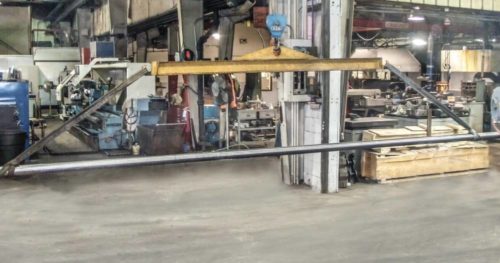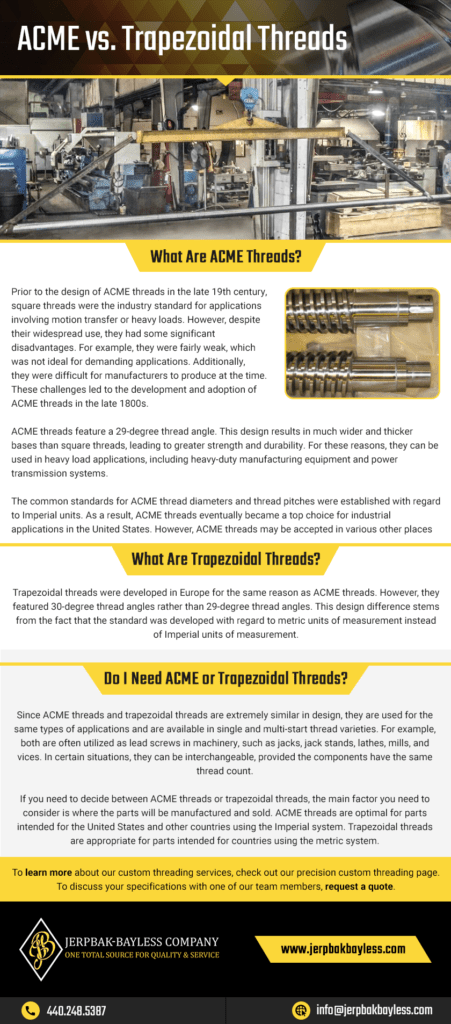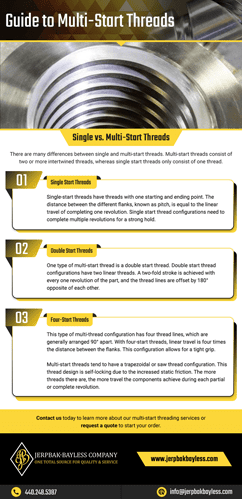ACME vs. Trapezoidal Threads
Leave a CommentAt first glance, ACME threads and trapezoidal threads appear very similar. In fact, they do have numerous similarities, including purpose and time of development, which make them suitable for many of the same applications. However, they do have some differences which can affect when you may want to use them. For example, ACME threads were developed with regard to Imperial units, so they are commonly used in the United States. On the other hand, trapezoidal threads were developed with regard to metric units, so they are standard for European countries.
Below, we go more in-depth into the history, advantages, and applications of these two thread types to help readers better understand when they may want to use one over the other.
What Are ACME Threads?
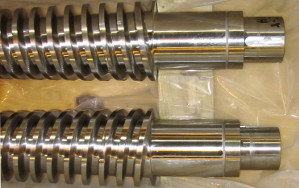
ACME threads feature a 29-degree thread angle. This design results in much wider and thicker bases than square threads, leading to greater strength and durability. For these reasons, they can be used in heavy load applications, including heavy-duty manufacturing equipment and power transmission systems.
The common standards for ACME thread diameters and thread pitches were established with regard to Imperial units. As a result, ACME threads eventually became a top choice for industrial applications in the United States. However, ACME threads may be accepted in various other places across the globe.
What Are Trapezoidal Threads?
Trapezoidal threads were developed in Europe for the same reason as ACME threads. However, they featured 30-degree thread angles rather than 29-degree thread angles. This design difference stems from the fact that the standard was developed with regard to metric units of measurement instead of Imperial units of measurement.
Do I Need ACME or Trapezoidal Threads?
Since ACME threads and trapezoidal threads are extremely similar in design, they are used for the same types of applications and are available in single and multi-start thread varieties. For example, both are often utilized as lead screws in machinery, such as jacks, jack stands, lathes, mills, and vices. In certain situations, they can be interchangeable, provided the components have the same thread count.
If you need to decide between ACME threads or trapezoidal threads, the main factor you need to consider is where the parts will be manufactured and sold. ACME threads are optimal for parts intended for the United States and other countries using the Imperial system. Trapezoidal threads are appropriate for parts intended for countries using the metric system.
Learn More About Threads From Jerpbak-Bayless Company
Want additional information on ACME threads and trapezoidal threads? Ask the experts at Jerpbak-Bayless Company! We are a precision machining company with extensive experience providing superior custom threading services. From ACME threads to trapezoidal threads to square threads, we do it all. If you have any questions or concerns about a particular thread type or threads in general, we can answer and address them.
Looking for a threading partner for your next project? We’ve got you covered. Equipped with a vast equipment inventory, including precision thread cutting machines, we create a range of threaded parts and products. Our capabilities include:
- Threading processes: thread grinding, thread milling, thread cutting, multi-start threads
- Part length: unlimited lengths
- Part outer diameter: 1.5–34 inches
- Roundness: Up to .0001 inches
- Concentricity: Up to .0003 inches
- Tolerance: ±.0005 inches
- Production volume: 1–1000 pieces
To learn more about our custom threading services, check out our precision custom threading page. To discuss your specifications with one of our team members, request a quote.
Guide to Multi-Start Threads
Leave a Comment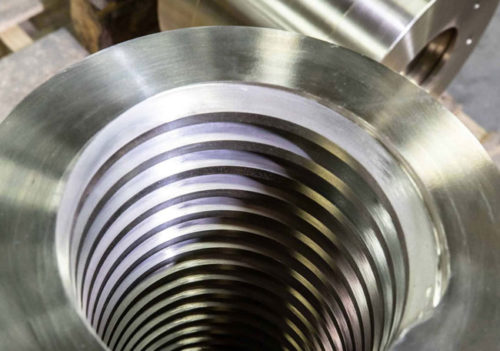
Single vs. Multi-Start Threads
There are many differences between single and multi-start threads. Multi-start threads consist of two or more intertwined threads, whereas single start threads only consist of one thread.
Single Start Threads
Single-start threads have threads with one starting and ending point. The distance between the different flanks, known as pitch, is equal to the linear travel of completing one revolution. Single start thread configurations need to complete multiple revolutions for a strong hold.
Double Start Threads
One type of multi-start thread is a double start thread. Double start thread configurations have two linear threads. A two-fold stroke is achieved with every one revolution of the part, and the thread lines are offset by 180° opposite of each other.
Four-Start Threads
This type of multi-thread configuration has four thread lines, which are generally arranged 90° apart. With four-start threads, linear travel is four times the distance between the flanks. This configuration allows for a tight grip.
Multi-start threads tend to have a trapezoidal or saw thread configuration. This thread design is self-locking due to the increased static friction. The more threads there are, the more travel the components achieve during each partial or complete revolution.
Applications of Multi-Start Threads
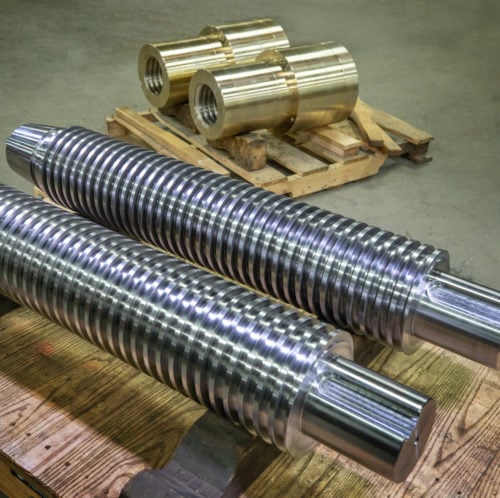
Multi-start threads are used for transmitting power and generating movement. Because each partial or complete revolution equals more linear travel based on the number of threads, multi-threaded components can efficiently handle more power. Multi-start threads can also be used for some fastening purposes. Products that need to create a water- or air-tight seal perform better with multi-start threads. The following industrial products often utilize multi-start threads:
- Gate valves
- Satellite roller screws
- Planetary roller screws
- Threaded rods
- Vertical turret lathes
- Fly presses
- Buttress threads
- Higbee threads
- Multi-Start Thread Machining Process
All threading processes require precise machining. Expert machinists handle the process by first determining the exact measurements for the lead, lead angle, and pitch of the multi-start thread. Next, the machinist will use a single form thread mill to helically interlope the first thread at the proper lead. After the first thread has been cut, the machinist will navigate the thread mill to the starting point of the next thread, and proceed until all remaining threads have been cut.
Multi-Start Threading From Jerpbak-Bayless
At Jerpbak-Bayless, we specialize in custom thread grinding services for multi-start thread configurations. Our machinists can create internal and external threads in any form or configuration to suit static friction requirements for various applications. Along with precision threading, we provide in-house testing and inspection services to ensure products meet strict tolerances and our high production standards. Contact us today to learn more about our multi-start threading services or request a quote to start your order.


